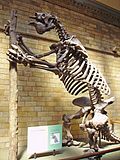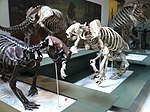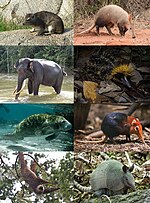Xenarthra (/zɛˈnɑːrθrə/; from Ancient Greek ξένος, xénos, "foreign, alien" + ἄρθρον, árthron, "joint") is a major clade of placental mammals native to...
26 KB (2,789 words) - 01:54, 27 October 2024
species of which exist solely on sloths. Sloths belong to the superorder Xenarthra, a group of placental mammals believed to have evolved in the continent...
50 KB (5,432 words) - 03:14, 21 October 2024
three major subdivisions or lineages of placental mammals: Boreoeutheria, Xenarthra, and Afrotheria. All of these diverged from common ancestors. 2022 studies...
23 KB (2,336 words) - 19:33, 10 November 2024
DNA from the extinct South American giant glyptodont Doedicurus sp. (Xenarthra: Glyptodontidae) reveals that glyptodonts evolved from Eocene armadillos"...
18 KB (1,522 words) - 12:36, 14 October 2024
anatomy with "edentate" mammals (now recognised as members of the order Xenarthra) in the collection of the Paris museum, correctly recognised that the...
51 KB (5,555 words) - 17:11, 2 November 2024
placental mammals in the order Cingulata. They form part of the superorder Xenarthra, along with the anteaters and sloths. 21 extant species of armadillo have...
36 KB (3,519 words) - 09:22, 30 October 2024
Cingulata, part of the superorder Xenarthra, is an order of armored New World placental mammals. Dasypodids and chlamyphorids, the armadillos, are the...
20 KB (1,370 words) - 17:35, 1 October 2024
sloths are a diverse group of extinct sloths in the mammalian superorder Xenarthra. They varied widely in size with the largest, belonging to genera Lestodon...
58 KB (5,999 words) - 14:37, 4 November 2024
and Pampatheridae. Cingulata is itself within the basal mammal group Xenarthra, which includes an array of American mammal groups like Vermilingua (anteaters)...
117 KB (12,956 words) - 12:36, 14 October 2024
(magnorder) of placental mammals containing the cohorts or superorders Xenarthra and Afrotheria. These groups originated and radiated in the South American...
9 KB (559 words) - 19:00, 22 September 2024








